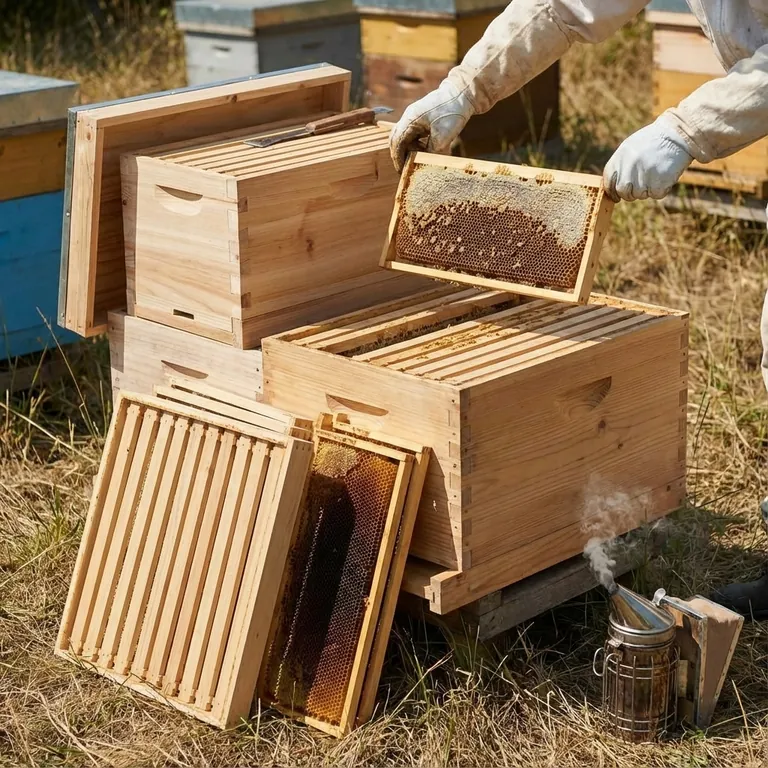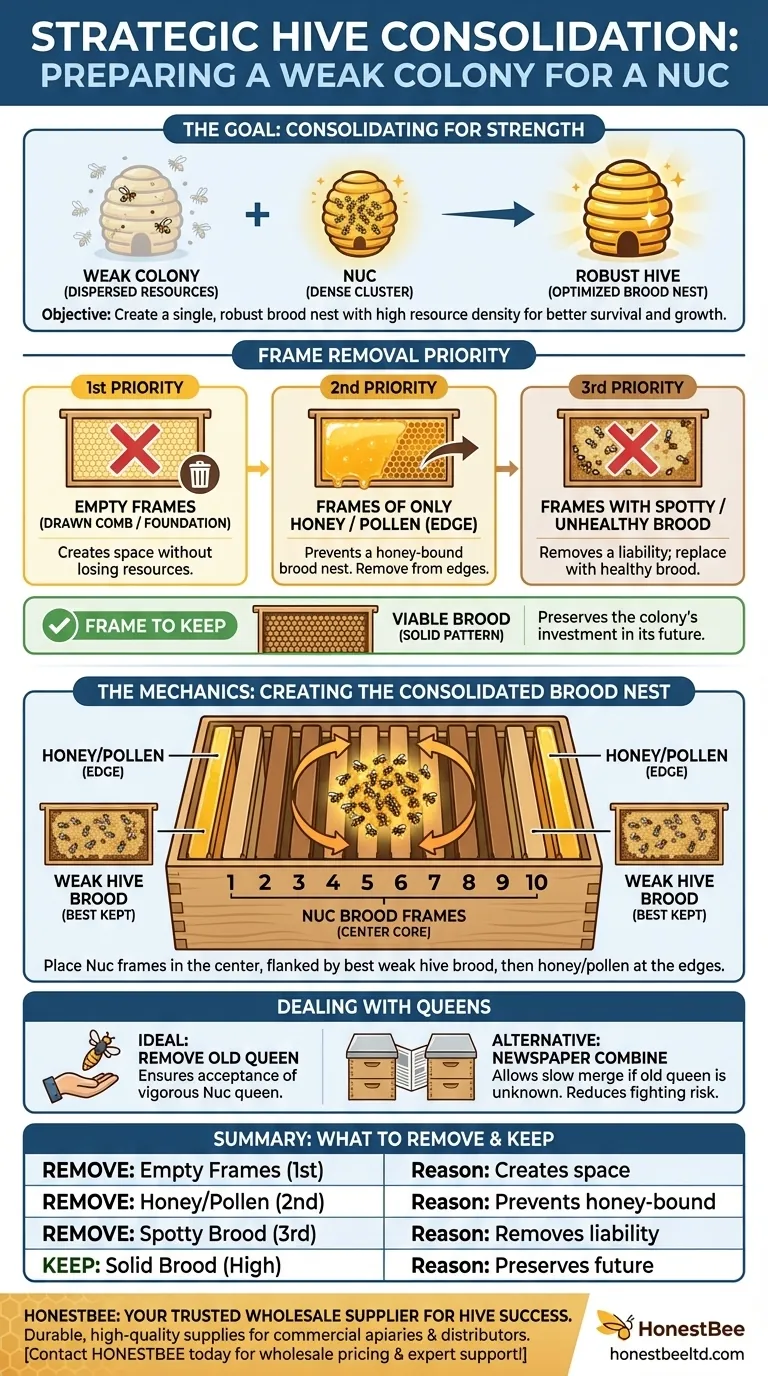To make space for a nuc, you should remove the least productive frames from the weak colony. Prioritize removing empty drawn combs or foundation first. If more space is needed, remove frames that contain only honey and pollen from the edges of the brood area, or frames with a very sparse, spotty brood pattern. The goal is to consolidate the hive's valuable resources, not just to clear space.
Your objective is not simply to swap frames, but to perform a strategic consolidation. By removing the weakest frames and adding the dense, healthy resources from a nucleus colony, you are creating a single, robust brood nest that has a much higher chance of survival and growth.

The Goal: Consolidating for Strength
Combining a nuc with a weak hive is a powerful technique to save a failing colony. The underlying principle is to increase the density of resources, particularly brood and the bees that care for them.
Why Resource Density Matters
A weak colony often has its resources (a little brood here, some honey there) spread across many frames. This makes it difficult for the diminished population to thermoregulate the brood nest and efficiently feed the larvae.
A nucleus colony, by contrast, is by definition a dense cluster of bees on frames packed with brood and food. By combining them, you create a powerful core that can properly manage its temperature and grow quickly.
Assessing the Weak Colony's Frames
When deciding which frames to remove, think in terms of their value to the colony's immediate survival and growth. Remove them in this order of priority:
1. Empty Frames (Foundation or Drawn Comb) These are the easiest choice. They provide no immediate food or brood and can be stored for later use. Removing them creates space without impacting the colony's current population or food stores.
2. Frames of Only Honey or Pollen A colony needs food, but a "honey bound" brood nest—where the queen has no room to lay because cells are filled with nectar or honey—is a common problem. Removing one or two frames of stores from the edge of the brood nest is an excellent way to make room for active brood frames.
3. Frames with Spotty or Unhealthy Brood A frame with a poor brood pattern—scattered cells, a high percentage of drone brood, or signs of disease—is a liability. It requires resources to maintain but offers little in return. It is far better to replace this with a solid frame of healthy, capped brood from the nuc.
4. What NOT to Remove: Viable Brood Avoid removing frames with a solid pattern of eggs and young larvae, as this indicates the current queen is still active. These frames represent the colony's most recent investment in its future. The goal is to supplement this viable brood, not discard it.
The Mechanics of a Successful Combination
Properly arranging the frames is just as important as choosing which ones to remove.
Preparing the Hive
You will typically remove five frames from your 10-frame deep box to make room for the five frames of the incoming nuc.
Arranging the New Brood Nest
The key is to create a consolidated brood area. Place the brood frames from the nuc in the center of the box, all together. Then, place the best brood frames you kept from the weak colony directly beside the nuc frames.
Finally, place the frames of honey and pollen on the outer edges of this new, consolidated brood nest. This configuration ensures the brood is kept warm and is easily cared for by the nurse bees.
Dealing with Two Queens
When you combine a nuc (which has a queen) with a weak colony (which likely has a failing queen), you will have two queens in one hive. The ideal method is to find and remove the queen from the weak colony before introducing the nuc frames. This ensures the younger, more vigorous nuc queen is accepted.
If you cannot find the old queen, you can let the bees sort it out, but this can lead to fighting and potential rejection of the new queen.
Understanding the Trade-offs
Boosting a weak hive is a calculated decision with clear benefits and minor risks.
The Risk of Inaction
A weak hive is a target. It is vulnerable to robbing from stronger hives and infestation by pests like wax moths and small hive beetles. Left alone, most weak hives will not recover and will eventually perish.
The Risk of Combining
There is a small chance the colonies will fight, especially if the original queen is not removed. To minimize this, you can use a newspaper combine. This involves placing a sheet of newspaper with small slits cut in it between the old hive body and the new nuc box, allowing the bees to slowly merge as they chew through it.
The Cost of a Nuc
A nucleus colony is an investment of time or money. However, this cost is almost always less than the value of the honey production you gain from a strong hive or the cost of replacing dead-out equipment.
Making the Right Choice for Your Goal
Your approach may vary slightly depending on the specific situation.
- If your primary focus is saving a rapidly failing colony: Remove the old queen and consolidate the best brood from both hives into a tight central cluster, surrounded by food.
- If your primary focus is boosting a slow but otherwise healthy hive: Prioritize removing empty frames and excess honey frames to give the queen more laying space, keeping all healthy brood from the original hive.
- If you are unsure of the original queen's quality or cannot find her: Use the newspaper combine method to let the colonies merge slowly and allow the bees to select the superior queen.
By strategically consolidating resources, you transform a vulnerable colony into a thriving and productive one.
Summary Table:
| Frame Type to Remove | Priority | Reason |
|---|---|---|
| Empty Frames (Drawn Comb/Foundation) | 1st | Creates space without losing resources. |
| Frames of Only Honey/Pollen | 2nd | Prevents a honey-bound brood nest. |
| Frames with Spotty/Unhealthy Brood | 3rd | Removes a liability; replaces with healthy brood. |
| Frame Type to KEEP | Priority | Reason |
| Frames with Solid Brood Pattern | High | Preserves the colony's investment in its future. |
Ready to strengthen your apiary with the right equipment?
As a trusted wholesale supplier to commercial apiaries and beekeeping equipment distributors, HONESTBEE provides the durable, high-quality supplies you need for successful hive management—from nuc boxes to full hive setups. Let us help you build a more resilient and productive operation.
Contact HONESTBEE today for wholesale pricing and expert support!
Visual Guide

Related Products
- 5 Frame Wooden Nuc Box for Beekeeping
- Automatic Heat Preservation 6 Frame Pro Nuc Box for Honey Bee Queen Mating
- Twin Queen Styrofoam Honey Bee Nucs Mating and Breeding Box
- Styrofoam Mini Mating Nuc Box with Frames Feeder Styrofoam Bee Hives 3 Frame Nuc Box
- Portable Bee Mating Hive Boxes Mini Mating Nucs 8 Frames for Queen Rearing
People Also Ask
- How should the nuc be installed in the apiary? Ensure Colony Success from Day One
- What frames should be moved into the queenless hive when requeening with a nuc? Ensure a Successful Queen Introduction
- How many frames does a typical wooden nuc box hold? A Guide to Choosing the Right Size
- What are the benefits of moving nuclei around the apiary? Master Strategic Hive Management
- What are the benefits of using nucs for beginning beekeepers? Ensure a Successful First Hive with a Head Start



















